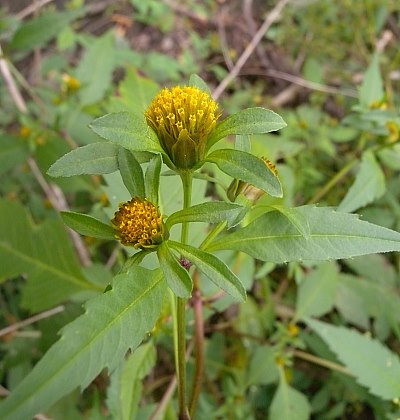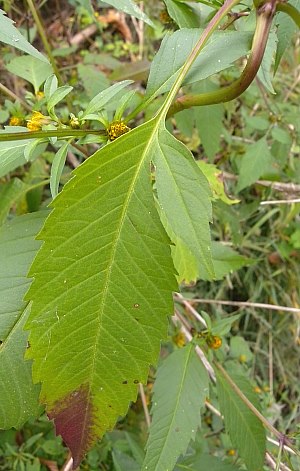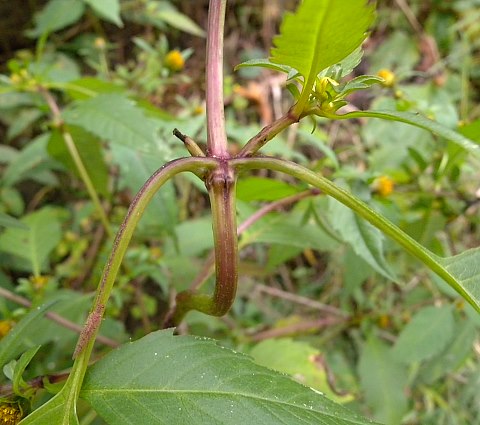
The upper stems terminate in 1-3 flowerheads each on peduncles about ½-4" long. The peduncles are light green or purplish green, more or less terete, and glabrous. Each flowerhead spans ½-1¼" across (excluding the leafy bracts), consisting of numerous disk florets and usually no ray florets. When ray florets occur, they are insignificant and few in number. The corollas of the disk florets are yellow to orange, narrowly tubular in shape, and about 3 mm. (1/8") long; each corolla has 4-5 recurved to ascending lobes along its upper rim. The disk florets are perfect, while the ray florets, if they are present, are sterile. Surrounding the disk florets are about 8 floral bracts (phyllaries) that are yellowish brown or yellowish black, ovate in shape, and glabrous; they are about 6 mm. (¼") long. Originating from below both the disk florets and floral bracts, but spreading outward, there are 3-8 leafy bracts about ½-1½" long. The leafy bracts are green, glabrous, and oblanceolate, elliptic, or oblong in shape. The blooming period occurs from late summer into the fall, lasting about 1-2 months. The disk florets are replaced by awned achenes that are about 5-6 mm. in length (excluding the awns), oblanceolate in shape, and somewhat flattened. At the apex of each achene, there are 4 barbed awns consisting of two longer outer awns (about 4 mm. in length) and two shorter inner awns (about 2 mm. in length). However, because the 2 inner awns are fragile and often become detached, some achenes will have only 2-3 awns (or even less, should the outer awns become detached). The root system consists of a shallow branching taproot. This plant reproduces by reseeding itself, occasionally forming colonies.

Cultivation: The preference is full sun to moderate shade and wet to moist conditions. Various types of soil are tolerated, including those that contain loam, silt, and clay. This plant is somewhat weedy.
Range & Habitat: The native Purple-Stemmed Tickseed is occasional in the northern half of Illinois, becoming uncommon or absent in the southern half of the state (see Distribution Map). Habitats consist of marshes, muddy areas of seasonal wetlands, streambanks, swamps, and ditches. Areas with a history of disturbance from flooding or other causes are preferred.

Faunal Associations: Robertson (1929) observed bumblebees sucking nectar from the flowerheads of Purple-Stemmed Tickseed. It is also likely that Halictid bees and miscellaneous flies also visit the flowerheads for nectar or pollen. The following aphids suck plant juices from this and other Bidens spp.: Aphis coreopsidis, Pemphigus tartareus, and Uroleucon chrysanthemi. The following leaf beetles feed on these plants and similar members of the Aster family: Calligrapha bidenticola, Calligrapha californica, and Calligrapha elegans. Other insects include foliage-consuming caterpillars of the butterfly Nathalis iole (Dainty Sulphur) and flowerhead-consuming larvae of the fruit fly Icterica seriata. The caterpillars of several moths feed on the foliage, feed on the flowerheads, or bore through the stems of Bidens spp. These species include Cirrhophanus triangulifer (Goldenrod Stowaway), Condica confederate (The Confederate), Condica mobilis (Mobile Groundling), and Epiblema otiosana (Bidens Borer Moth). Some vertebrate animals also feed on these plants. Such turtles as Chelydra serpentina (Snapping Turtle), Chrysemys picta (Painted Turtle), and Emys blandingii (Blanding's Turtle) eat the foliage or seeds (Ernst et al., 1994; Lagler, 1943). Several ducks, upland gamebirds, and granivorous songbirds also eat the seeds, including such species as the Wood Duck, Mallard, Black Duck, Wild Turkey, Ring-Necked Pheasant, Greater Prairie Chicken, Bobwhite Quail, Purple Finch, Common Redpoll, Swamp Sparrow, Pine Grosbeak, and Eastern Goldfinch (Martin et al., 1951/1961; Eastman, 2003). The foliage is eaten by the White-Tailed Deer and Cottontail Rabbit, although it is not a preferred source of food. Because the barbed awns of the achenes can cling to the fur of animals and the clothing of humans, they can be carried considerable distances to new locations.

Photographic Location: A shaded streambank at Meadowbrook Park in Urbana, Illinois.
Comments: This plant and other Bidens spp. are occasionally parasitized by various Cuscuta spp. (Dodders); the latter are vine-like plants without chlorophyll that often occur in wetlands. Because its ray florets are insignificant or absent, Purple-Stemmed Tickseed is one of the less showy species in this genus. It is relatively easy to confuse this species with other species in this genus that share this characteristic. In particular, Bidens comosa (Leafy-Bracted Tickseed) is similar in appearance. This latter species can be distinguished by the shorter petioles of its leaves (which are often winged), its longer leafy bracts (up to 2½" long), and the yellowish color of its stems. In addition, the corollas of the disk florets for this species have 4 lobes more often than 5 lobes, while the reverse is true for Purple-Stemmed Tickseed. The achenes of Purple-Stemmed Tickseed are also distinct: each of its achenes has 2 long outer awns and 2 short inner awns, although these awns (particularly the inner ones) often break off.